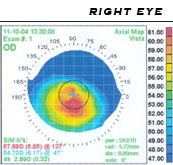
Photo from wikipedia
Purpose: To evaluate the intrasession repeatability and validity of posterior corneal curvature and astigmatism measurements provided by a color light-emitting diode reflection topography system in healthy eyes. Methods: A total… Click to show full abstract
Purpose: To evaluate the intrasession repeatability and validity of posterior corneal curvature and astigmatism measurements provided by a color light-emitting diode reflection topography system in healthy eyes. Methods: A total of 40 healthy eyes of 40 patients (age, 16–66 years) were enrolled. A complete eye examination was performed in all cases including posterior topographic analysis with two systems: the Scheimpflug-based system (Pentacam; Oculus Optikgeräte GmbH, Wetzlar, Germany) and the Cassini system (i-Optics; Ophthec, The Hague, The Netherlands). With this last system, three consecutive measurements were taken to assess the level of intrasession repeatability (within-subject standard deviation, Sw; intraclass correlation coefficient). The Bland & Altman analysis was used to evaluate the interchangeability of both devices. Results: The Sw was ⩽0.06 mm for all posterior corneal radius measurements, with intraclass correlation coefficient of ⩾0.960. The Sw for the magnitude of astigmatism, J0, and J45 were 0.15, 0.04, and 0.04 D, respectively, with intraclass correlation coefficient values of 0.876, 0.897, and 0.840, respectively. Statistically significant differences between devices were found in all parameters evaluated (p ⩽ 0.025). The interchangeability analysis revealed the presence of clinically relevant limits of agreement for the flattest (0.03 to 0.50 mm) and steepest posterior corneal radii (–0.01 to 0.39 mm). In contrast, limits of agreements were not clinically relevant for the magnitude of posterior astigmatism (–0.17 to 0.27 D) and their power vector components (–0.11 to 0.15 D). Conclusion: The Cassini system provides consistent measures of posterior corneal curvature and astigmatism in healthy eyes, but only measures of posterior astigmatism can be considered as interchangeable with those provided by the Pentacam.
Journal Title: European Journal of Ophthalmology
Year Published: 2019
Link to full text (if available)
Share on Social Media: Sign Up to like & get
recommendations!